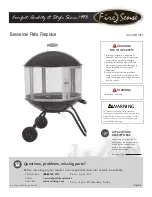
Residential Gas Water Heater Use and Care Guide • 31
MAINTENANCE
NOTICE:
Do not attempt to light
the water heater until the tank is
completely full of water. For complete
instructions on filling the tank, follow
Step 8 in the “Installation” section.
10
Refill the tank by opening the
cold water supply valve.
Make sure a hot water faucet
is open and the drain valve is closed.
Allow a hot water faucet to run full for
at least three minutes to make sure
the tank has all the air removed and is
completely full of water. Once you are
certain the tank is completely full of
water, close the hot water faucet.
11
Relight the pilot using the
instructions on page 24
and adjust the gas control
knob to the desired temperature. It
may take an hour or more for the tank
of cold water to heat up.
Visual Inspection
On an annual basis, visually inspect
the venting and air supply system,
piping systems, main burner, and pilot
burner.
Check the water heater for the
following:
•
Obstructions, damage, or deterio
-
ration in the venting system. Make
sure the ventilation and combustion
air supplies are not obstructed.
• Buildup of soot and carbon on the
main burner and pilot burner. The
burner may be cleaned with soap
and hot water.
•
Inspect the burner flames through
the viewport and compare them
to the drawing above. A properly
operating burner should produce a
soft blue flame. Blue tips with yellow
inner cones are satisfactory. The tips
of the flame may have a slight yel
-
low tint. The flame should not be all
yellow or have a sharp blue-orange
color. Contaminated air may cause
an orange colored flame. Contact a
qualified technician if the flame is
not satisfactory.
Correct Flame
Soft Blue
Figure 51 -
Burner Flames
•
Leaking or damaged water and gas
piping.
•
Remove any flammable, corrosive
or combustible materials near the
water heater.
If you lack the necessary skills
required to properly perform this
visual inspection or if the burner
needs to be cleaned, get help from a
qualified person.
T&P Relief Valve Maintenance
Figure 52 - T&P Relief Valve
Read and follow the operating and
annual maintenance instructions
provided by the manufacturer of
the T&P Relief Valve (yellow label
attached to T&P Relief Valve). If no
label is attached to the T&P Relief
Valve, follow the instructions in this
section.
Minerals in the water can form
deposits that cause the valve to stick
or create blocked passages, making
the T&P Relief Valve inoperative.
Follow these guidelines:
•
At least annually, operate the T&P
Relief Valve manually to ensure the
waterways are clear and the valve
mechanism moves freely (above).
Before opening the valve manually,
check that it will discharge in a place
for secure disposal.
•
After manually operating T&P Relief
Valve, remove any water in the drain
pan and wipe away any water from
the heater.
WARNING! Hot water will be
released. Before opening the T&P
Relief Valve manually, check that it
will discharge in a safe place. If water
does not flow freely from the end
of the discharge pipe, turn the gas
control knob to the OFF position and
call a qualified person to determine
the cause.
•
At least every five years, have a
qualified person inspect the T&P
Relief Valve and discharge pipe.
Damage caused by corrosive water
conditions, mineral deposits, or
other problems can only be de-
termined when a qualified person
removes and inspects the valve and
its components.
Note that a dripping T&P Relief Valve
is usually caused by the home’s water
pressure being too high and/or lack of
a Thermal Expansion Tank. If your T&P
Relief Valve drips, see page 27.
A T&P Relief Valve that has been
allowed to drip for an appreciable
period of time should be inspected for
mineral buildup.
MAINTENANCE






































